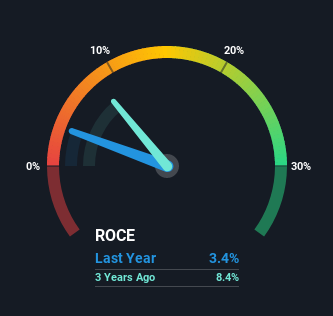- Singapore
- /
- Hospitality
- /
- SGX:H07
Returns On Capital At Stamford Land (SGX:H07) Paint A Concerning Picture

If we want to find a stock that could multiply over the long term, what are the underlying trends we should look for? Typically, we'll want to notice a trend of growing return on capital employed (ROCE) and alongside that, an expanding base of capital employed. Basically this means that a company has profitable initiatives that it can continue to reinvest in, which is a trait of a compounding machine. Having said that, from a first glance at Stamford Land (SGX:H07) we aren't jumping out of our chairs at how returns are trending, but let's have a deeper look.
Understanding Return On Capital Employed (ROCE)
Just to clarify if you're unsure, ROCE is a metric for evaluating how much pre-tax income (in percentage terms) a company earns on the capital invested in its business. The formula for this calculation on Stamford Land is:
Return on Capital Employed = Earnings Before Interest and Tax (EBIT) ÷ (Total Assets - Current Liabilities)
0.034 = S$35m ÷ (S$1.1b - S$56m) (Based on the trailing twelve months to September 2020).
So, Stamford Land has an ROCE of 3.4%. On its own that's a low return, but compared to the average of 0.9% generated by the Hospitality industry, it's much better.
See our latest analysis for Stamford Land

Historical performance is a great place to start when researching a stock so above you can see the gauge for Stamford Land's ROCE against it's prior returns. If you want to delve into the historical earnings, revenue and cash flow of Stamford Land, check out these free graphs here.
The Trend Of ROCE
When we looked at the ROCE trend at Stamford Land, we didn't gain much confidence. To be more specific, ROCE has fallen from 13% over the last five years. Given the business is employing more capital while revenue has slipped, this is a bit concerning. This could mean that the business is losing its competitive advantage or market share, because while more money is being put into ventures, it's actually producing a lower return - "less bang for their buck" per se.
On a related note, Stamford Land has decreased its current liabilities to 5.1% of total assets. That could partly explain why the ROCE has dropped. Effectively this means their suppliers or short-term creditors are funding less of the business, which reduces some elements of risk. Since the business is basically funding more of its operations with it's own money, you could argue this has made the business less efficient at generating ROCE.
What We Can Learn From Stamford Land's ROCE
From the above analysis, we find it rather worrisome that returns on capital and sales for Stamford Land have fallen, meanwhile the business is employing more capital than it was five years ago. Investors haven't taken kindly to these developments, since the stock has declined 18% from where it was five years ago. Unless there is a shift to a more positive trajectory in these metrics, we would look elsewhere.
Since virtually every company faces some risks, it's worth knowing what they are, and we've spotted 3 warning signs for Stamford Land (of which 1 is significant!) that you should know about.
While Stamford Land isn't earning the highest return, check out this free list of companies that are earning high returns on equity with solid balance sheets.
When trading Stamford Land or any other investment, use the platform considered by many to be the Professional's Gateway to the Worlds Market, Interactive Brokers. You get the lowest-cost* trading on stocks, options, futures, forex, bonds and funds worldwide from a single integrated account. Promoted
If you're looking to trade Stamford Land, open an account with the lowest-cost platform trusted by professionals, Interactive Brokers.
With clients in over 200 countries and territories, and access to 160 markets, IBKR lets you trade stocks, options, futures, forex, bonds and funds from a single integrated account.
Enjoy no hidden fees, no account minimums, and FX conversion rates as low as 0.03%, far better than what most brokers offer.
Sponsored ContentNew: Manage All Your Stock Portfolios in One Place
We've created the ultimate portfolio companion for stock investors, and it's free.
• Connect an unlimited number of Portfolios and see your total in one currency
• Be alerted to new Warning Signs or Risks via email or mobile
• Track the Fair Value of your stocks
This article by Simply Wall St is general in nature. It does not constitute a recommendation to buy or sell any stock, and does not take account of your objectives, or your financial situation. We aim to bring you long-term focused analysis driven by fundamental data. Note that our analysis may not factor in the latest price-sensitive company announcements or qualitative material. Simply Wall St has no position in any stocks mentioned.
*Interactive Brokers Rated Lowest Cost Broker by StockBrokers.com Annual Online Review 2020
Have feedback on this article? Concerned about the content? Get in touch with us directly. Alternatively, email editorial-team (at) simplywallst.com.
About SGX:H07
Stamford Land
An investment holding company, owns, operates, and manages hotels in Singapore, Australia, and the United Kingdom.
Flawless balance sheet and fair value.
Similar Companies
Market Insights
Community Narratives




